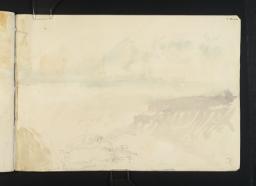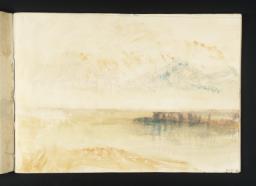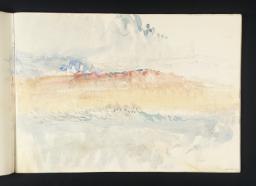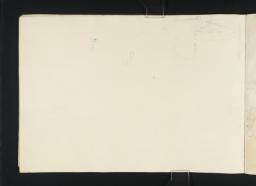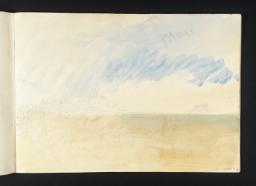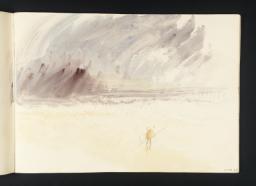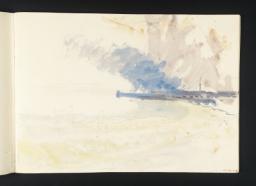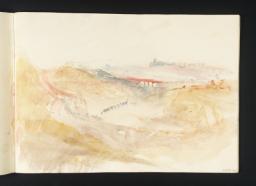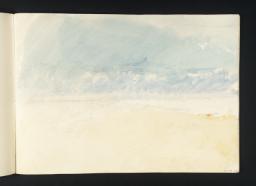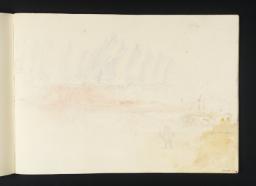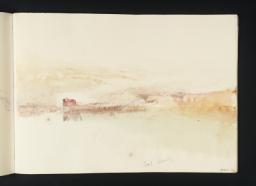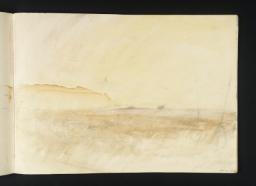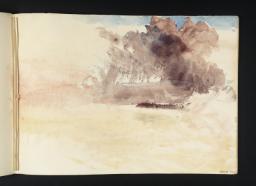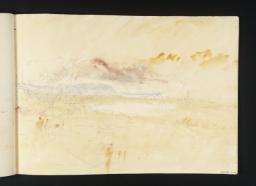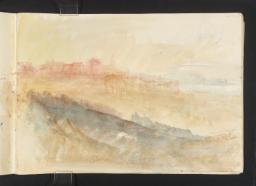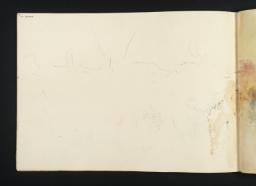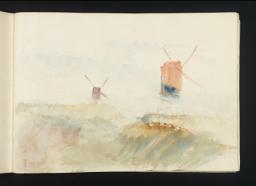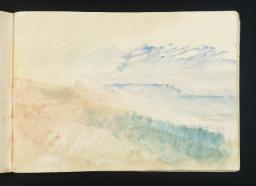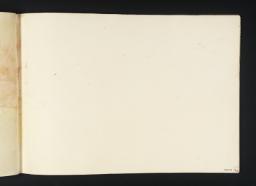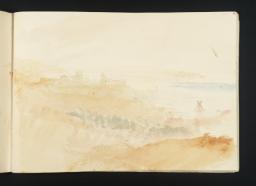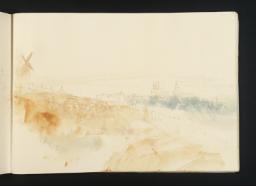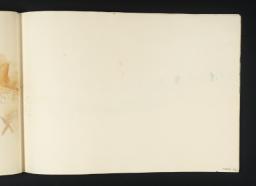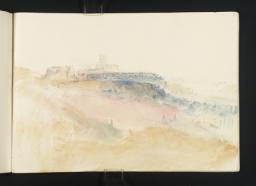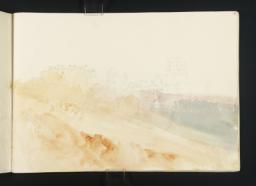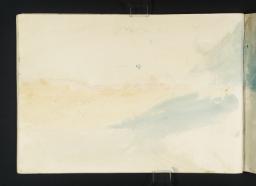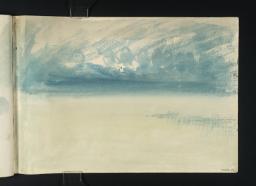Turner Bequest CCCLVIII 1–24
Roll sketchbook bound in green paper covers, with dark green cloth spine
22 leaves of white wove paper, approximate page size 230 x 328 mm
Various pages watermarked (see Technical notes)
Stamped in black ‘CCCLVIII.’ top centre of front cover
Inscribed in black ink ‘CCCLVIII.’ bottom right of front cover
22 leaves of white wove paper, approximate page size 230 x 328 mm
Various pages watermarked (see Technical notes)
Stamped in black ‘CCCLVIII.’ top centre of front cover
Inscribed in black ink ‘CCCLVIII.’ bottom right of front cover
Accepted by the nation as part of the Turner Bequest 1856
Exhibition history
References
The Boulogne sketchbook is one of the two known ‘roll sketchbooks’ that Turner took with him on his restorative trip to northern France in May 1845, as discussed in the Introduction to this tour. Although the other sketchbook (Ambleteuse and Wimereux; Tate; Turner Bequest CCCLVII) was broken up in the twentieth century, this volume remains bound between the soft paper covers that allowed such items to be conveniently rolled up and carried about in a pocket.1 The sequence in which the sketches are catalogued follows the foliation established by Ruskin in the mid-nineteenth century, although the sketchbook had no designated front or back when acquired by Turner. This fact is reflected by the way in which the artist has worked roughly to the centre of the book, inverted it, and seemingly worked back to the middle from the other end. The two sequences of sketches produced by this action, each upside down relative to the other, divide between them the two main preoccupations of the book: views of the actual town of Boulogne on the one hand and, on the other, scenes derived from the neighbouring coastline.
Boulogne had undergone significant changes since Turner’s last recorded visit some twenty years earlier.2 The town was still one of France’s most important fishing ports although its Napoleonic heyday as a naval garrison was now firmly in the past. Instead, Boulogne’s economy was already coming to rest substantially upon its reputation as a fashionable bathing resort which, along with the picturesque attractions of the medieval citadel, drew growing numbers of tourists from both sides of the channel.3 The harbour now saw the regular coming and going of ‘steam packets’ from English ports while the town provided luxury accommodation, a museum, concert hall, public library, theatre, shopping parades, several English chapels, and the opulent Bathing Establishment for sea bathing and grand assemblies.
Of this newly fashionable and bustling side to Boulogne, Turner’s sketchbook gives little away but for a rough sketch of the bathing beach just north of the port on folio 14 recto (D35416). Instead, the sketches of the town tend to depict from varying distances and directions the medieval haute ville (literally, ‘high town’) which sat on the high ground to the east of the harbour. Often visible in the sketches are the haute ville’s encircling ramparts, the ancient bell tower with its distinctive stepped silhouette, and the curving walls and high gables of the castle.4 Evidence of Boulogne’s resurgent civic pride, however, is not wholly absent from these views. The town’s highest point and most prominent feature was the Basilique Notre-Dame de Boulogne then undergoing reconstruction subsequent to the destruction of the former cathedral during the Revolutionary period.5 The structure surmounting the haute ville, which often appears as a hulking square tower, is actually the unfinished dome of the basilica, complete only as far as its columned ‘drum’.
Tourists to Boulogne were encouraged to make short excursions to the attractive and historically interesting coastline stretching north and south of the town. Certainly Turner, armed with the Boulogne sketchbook, made the trip three miles north to the village of Wimereux ‘along the sands at low water, or on the top of the cliffs’ and beyond that to Ambleteuse.6 The ‘immense quantity of rocks ... of a very picturesque nature’ which littered the beaches recurs in the drawings, as do the colourful striations of the cliffs at Wimereux. In subsequent decades these villages grew into fashionable resorts in their own right but at this point amounted to ‘nothing but a sorry hamlet’ and a ‘wretched fishing village’.7 The small-scale industry of the region is indicated on several pages by the depiction of lone fishermen and little clusters of boats at harbour, or simply by the inscription of ‘fish women’ or ‘fishing village’ in place of an actual sketch.
But the sketchbook also reflects this coastline’s more glorious past, often focusing the eye on the physical traces of centuries of English hostilities. The seventeenth- and eighteenth-century forts at Ambleteuse and Wimereux feature in several of the sketches while Napoleonic ‘Martello’ forts punctuate the horizon line throughout the book’s coastal imagery. ‘Fort Napoleon’ is inscribed on folio 4 recto (D35407; Turner Bequest CCCLVIII 5) and could represent a number of sites on this heavily defended frontier upon which the Emperor stationed his grande armée ready for the failed invasion of 1805.8 The artist’s interest in the vestiges of this great event of his youth is further indicated by the presence of roughly jotted plans of artificial harbours at Boulogne and Wimereux. These structures had been constructed or extended by Napoleon to accommodate his fleet in the same period: see inside front cover (D35402; Turner Bequest CCCLVIII 1) and folio 2 verso (D35405; Turner Bequest CCCLVIII 3v).
Most of the sketches in this volume are characterised by economically scratched-in drawings washed over in brief, light watercolours. More akin to the Ambleteuse and Wimereux sketchbook are several views of unsettled skies upon which greater painterly virtuosity is expended. Folio 5 recto (D35408; Turner Bequest CCCLVIII 6) and folio 12 recto (D35415; Turner Bequest CCCLVIII 13) make almost impasto use of purple-brown pigment to indicate the lowering darkness of storm clouds and bold parallel strokes for the breaking of heavy showers.
Ian Warrell, ‘France’ in Evelyn Joll, Martin Butlin, and Luke Herrmann (eds.), The Oxford Companion to Turner, Oxford 2001, p.115.
Yves-Marie Hilaire, ‘Loisirs et vie de l’esprit dans une cité balénaire au XIXe siècle’ in Alain Lottin (ed.) Histoire de Boulogne-sur-Mer, Boulogne-sur-Mer 1998, pp.289–310.
See Pierre Boissé (ed.), Boulogne-sur-mer: le château et la haute-ville, Pas-de-Calais, Paris c.1988.
Technical notes
How to cite
John Chu, ‘Boulogne Sketchbook 1845’, sketchbook, November 2013, in David Blayney Brown (ed.), J.M.W. Turner: Sketchbooks, Drawings and Watercolours, Tate Research Publication, April 2015, https://www

